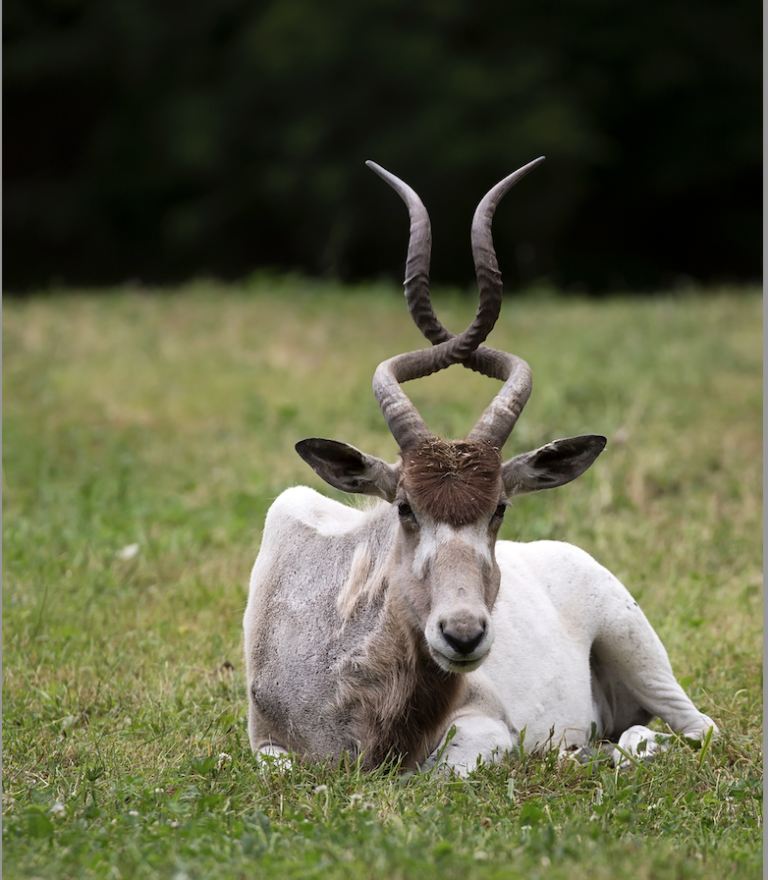Species in Peril:
Addax Antelope

Their beautiful horns make them a target
A Desert, Social Animal
Addax antelope live in arid environments in Chad, Niger, and other fragmented areas in northern sub-Saharan Africa. These animals are highly adapted to desert life. They are primarily nocturnal, especially during summer. During the day, they burrow into the sand in shady spots, and these depressions serve as cool resting spots and shelters from sandstorms. Herds tend to stick to one home range and only travel beyond it in quest of food. Addax have the ability to track rainfall and will seek regions with greater vegetation. In the summer, they tend to stay along the northern boundary of the tropical rain system. Then, as winter approaches, they move north.
Addax herds range in size from five to twenty members and include both males and females. These animals have a robust social structure, based on age, with herds led by the eldest male. Females create their own dominance hierarchies, while males are territorial and guard females.
Due to adult addax’s heavy bodies and relatively slow movements, they are an accessible prey for predators such as humans, lions, leopards, cheetahs, and African painted wolves. Calves are attacked by caracals, servals, and hyenas. If startled, addax may charge an intruder, but they are usually not violent.
Specialized Diet
As a desert creature, addax feed on grasses and the leaves of whatever shrubs, leguminous herbs, and bushes they may find.
They are primarily grazers, feeding on Aristida, Panicum, and Stipagrostis grasses. In the absence of these grasses, addax will only eat browse plants, such as Acacia tree leaves. They also consume perennials, which turn green and sprout when exposed to even a small amount of moisture or rain. Addax only eat certain sections of plants and prefer to neatly crop the Aristida grasses to the same height.
When grazing on Panicum grass, on the other hand, addax ignore the dry outer leaves, choosing instead to feast on the sensitive interior shoots and seeds. These seeds are crucial because they are addax’s primary source of protein.
Specialized Adaptations
Addax antelope are well-suited to live in the deep desert and its harsh conditions. They can survive almost completely without free-standing water since they absorb moisture from their diet and mist that condenses on plants. Scientists have discovered addax’s stomachs possess a unique lining that stores water in pouches for use in times of dehydration. Addax also produce extremely concentrated urine to reduce water loss from the body. Their pale coat color reflects radiant heat, while their body length and density aid in temperature regulation. During the day, addax congregate in shaded regions, and at night, they sleep in sand hollows. Addax’s bodies cool through evaporation.
Altogether, these adaptations work to dissipate heat from the body heat while conserving water within the body.
A Few More Facts About Addax Antelope
Addax possess broad, flat hooves with flat soles that help prevent them from sinking into the desert sand.
These antelopes are one of the few species where male and females have horns of the same size.
These desert antelopes’ coat color changes from dark grayish-brown in winter to white in the summer–an efficient method for maintaining steady body temperatures.
Addax will dig depressions in the sand in which to rest. These are often located in the shade of boulders for protection from the wind and sun.
Often considered the most-well adapted antelope to a desert environment, addax rarely need to drink since they are able to get most of the water they need from the plants they eat.
Addax herds typically consist of 5-20 individuals, led by one dominant male. Female herd members establish their own dominance hierarchy, with the oldest individuals achieving the highest rank.
Addax are one of the most endangered mammals in the world. Current estimates show there to be less than 500 individuals left in the wild
One of the Most Endangered Antelopes
The addax antelope is critically endangered, and efforts to save the species are essential. Oil exploration and extraction is taking over what remains of their habitat, so protecting the species will require cooperation between the oil industry, businesses, governments, communities, and conservationists.
Additionally, in the United States, places like Texas breed addax for trophy hunting. These animals should be bred only through a responsible species recovery plan that returns them to the wild and gives them a chance to survive in their natural environment. Speak out against states like Texas that sell this critically endangered animal to the highest bidder.
Species Name
Addax nasomaculatus
Estimated Population
50-100 in the wild
Conservation Status
Critically endangered
Range
Northern Africa
Reasons for Population Decline
Habitat loss
Hunting
Poaching
Roadkill


